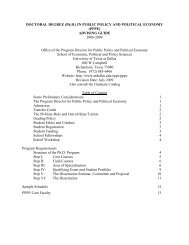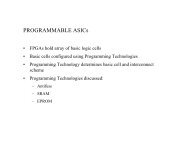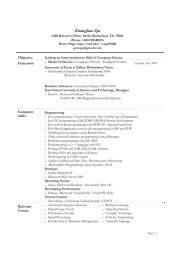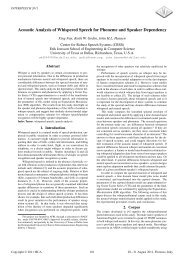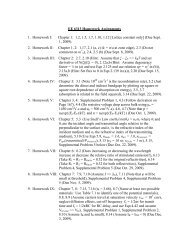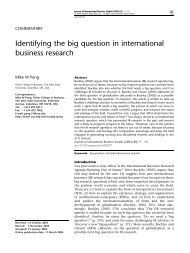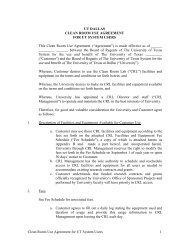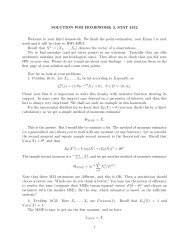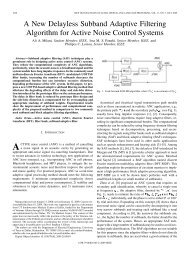Behind Intermediary Performance in Export Trade - The University of ...
Behind Intermediary Performance in Export Trade - The University of ...
Behind Intermediary Performance in Export Trade - The University of ...
Create successful ePaper yourself
Turn your PDF publications into a flip-book with our unique Google optimized e-Paper software.
INTERMEDIARY PERFORMANCE IN EXPORT TRADE<br />
the <strong>in</strong>formation asymmetry by <strong>in</strong>vest<strong>in</strong>g<br />
<strong>in</strong> monitor<strong>in</strong>g systems (e.g., hierarchy) to<br />
constra<strong>in</strong> agents’ opportunism or structure<br />
agent <strong>in</strong>centives <strong>in</strong> a way that both<br />
parties’ <strong>in</strong>terests are aligned. Such activities<br />
entail what are called agency costs,<br />
which are the ex ante costs <strong>of</strong> “monitor<strong>in</strong>g<br />
expenditures <strong>of</strong> the pr<strong>in</strong>cipal, the<br />
bond<strong>in</strong>g expenditures by the agent, and<br />
the residual loss” (Jensen and Meckl<strong>in</strong>g,<br />
1976, p. 308). <strong>The</strong>oretically, the best-perform<strong>in</strong>g<br />
<strong>in</strong>termediaries are likely to be<br />
those who can m<strong>in</strong>imize these agency<br />
costs for their clients, as opposed to<br />
those who can not, because the pr<strong>in</strong>cipals<br />
are more likely to choose the former<br />
over the latter.<br />
Resource-Based <strong>The</strong>ory<br />
Resource-based theory suggests that a<br />
firm’s competitive advantage is a function<br />
<strong>of</strong> its valuable, rare, and <strong>in</strong>imitable<br />
resources (Barney, 1991, 1997). 4 Such resources<br />
are <strong>of</strong>ten <strong>in</strong>tangible, embedded,<br />
and knowledge-based. In the case <strong>of</strong> export<br />
<strong>in</strong>termediaries, such skills as market<br />
knowledge and negotiation ability<br />
may play an important role <strong>in</strong> m<strong>in</strong>imiz<strong>in</strong>g<br />
the search and negotiation costs associated<br />
with export transactions. Additionally,<br />
some firms may have unique<br />
f<strong>in</strong>ancial resources which allow them to<br />
more successfully bond clients by tak<strong>in</strong>g<br />
title to goods and thus reduc<strong>in</strong>g client<br />
risk. In a nutshell, this theory suggests<br />
that the performance <strong>of</strong> export <strong>in</strong>termediaries<br />
depends on whether they can acquire<br />
and deploy resources <strong>in</strong> a way that<br />
cannot be easily imitated. Otherwise,<br />
manufacturers may attempt to develop<br />
export capabilities <strong>in</strong>-house. Indeed,<br />
many large manufacturers have done<br />
that, forc<strong>in</strong>g <strong>in</strong>termediaries to focus on<br />
smaller firms that are unable to acquire<br />
such capabilities, or on larger firms’ mar-<br />
g<strong>in</strong>al markets which have yet to command<br />
their <strong>in</strong>-house channels’ attention.<br />
Integration<br />
Although each <strong>of</strong> these theories illustrates<br />
one aspect <strong>of</strong> the export <strong>in</strong>termediary<br />
performance puzzle, all three seem<br />
necessary to pa<strong>in</strong>t a complete picture.<br />
Transaction cost theory is noteworthy<br />
for its analytical rigor <strong>in</strong> predict<strong>in</strong>g governance<br />
choices. Agency theory excels <strong>in</strong><br />
unpack<strong>in</strong>g the underly<strong>in</strong>g conflict between<br />
pr<strong>in</strong>cipals and agents. However,<br />
both theories address the issue from the<br />
pr<strong>in</strong>cipals’ standpo<strong>in</strong>t, and most transaction<br />
cost- and agency-based research <strong>in</strong>vestigates<br />
how manufacturers make<br />
channel choice decisions (Aulakh and<br />
Kotabe, 1997; Campa and Guillen, 1999).<br />
Such research, by allow<strong>in</strong>g little room<br />
for strategic behavior by agents, typically<br />
fails to consider that agents are not passive<br />
entities merely respond<strong>in</strong>g to pr<strong>in</strong>cipals’<br />
unilateral actions. Instead, agents<br />
such as <strong>in</strong>termediaries can also employ<br />
entrepreneurial strategies and organizational<br />
capabilities that can <strong>in</strong>fluence the<br />
relationship. Resource-based theory, by<br />
regard<strong>in</strong>g <strong>in</strong>termediaries as the focal<br />
firms, focuses on how such firms use<br />
their unique endowments <strong>of</strong> resources to<br />
lower transaction and agency costs for<br />
their clients and thus enhance their own<br />
performance. However, resource-based<br />
theory has been criticized that “at some<br />
level, everyth<strong>in</strong>g <strong>in</strong> the firm can become<br />
a resource and hence resources lose explanatory<br />
power” (Conner, 1991, p. 145).<br />
<strong>The</strong>refore, it seems that an <strong>in</strong>tegration <strong>of</strong><br />
these three theories may yield richer <strong>in</strong>sights.<br />
Our theoretical <strong>in</strong>tegration suggests<br />
that the nature <strong>of</strong> the export <strong>in</strong>termediary<br />
firm is that <strong>of</strong> an agent whose resources<br />
help lower export-related ex<br />
ante agency costs and ex post transaction<br />
330 JOURNAL OF INTERNATIONAL BUSINESS STUDIES



